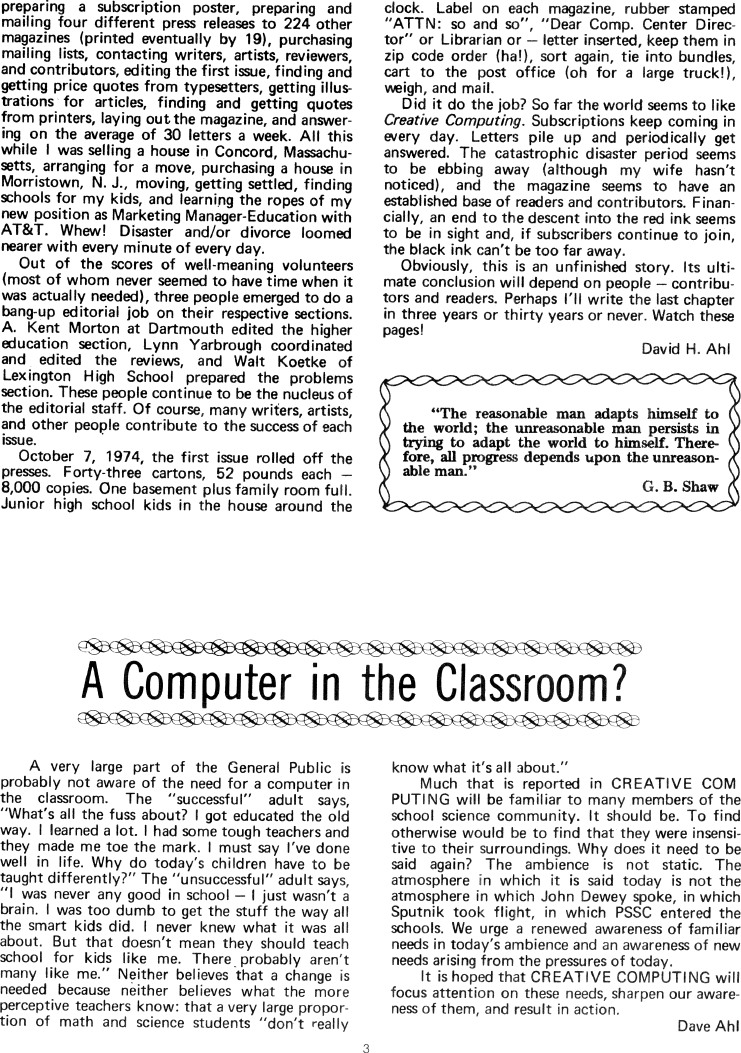The Best of Creative Computing Volume 1 (published 1976)
A Computer in the Classroom?

preparing a subscription poster, preparing and mailing four different press
releases to 224 other magazines (printed eventually by 19), purchasing mailing
lists, contacting writers, artists, reviewers,
and contributors, editing the first issue, finding and getting price quotes from
typesetters, getting illustrations for articles, finding and getting quotes from
printers, laying out the magazine, and answering on the average of 30 letters a
week. All this while l was selling a house in Concord, Massachusetts, arranging
for a move, purchasing a house in Morristown, N. J., moving, getting settled,
finding schools for my kids, and learning the ropes of my new position as
Marketing Manager-Education with AT&T. Whew! Disaster and/or divorce loomed
nearer with every minute of every day.
Out of the scores of well-meaning volunteers (most of whom never seemed to have
time when it was actually needed), three people emerged to do a bang-up
editorial job on their respective sections. A. Kent Morton at Dartmouth edited
the higher education section, Lynn Yarbrough coordinated and edited the reviews,
and Walt Koetke of Lexington High School prepared the problems section. These
people continue to be the nucleus of the editorial staff. Of course, many
writers, artists, and other people contribute to the success of each issue.
October 7, 1974, the first issue rolled off the presses. Forty-three cartons,
52 pounds each - 8,000 copies. One basement plus family room full. Junior high
school kids in the house around the clock. Label on each magazine, rubber
stamped "ATTN: so and so", "Dear Comp. Center Director” or Librarian or -
letter inserted, keep them in zip code order (ha!), sort again, tie into
bundles, cart to the post office (oh for a large truck!), weigh, and mail.
Did it do the job? So far the world seems to like Creative Computing.
Subscriptions keep coming in every day. Letters pile up and periodically get
answered. The catastrophic disaster period seems to be ebbing away (although my
wife hasn't noticed), and the magazine seems to have an established base of
readers and contributors. Financially, an end to the descent into the red ink
seems to be in sight and, if subscribers continue to join, the black ink can't
be too far away.
Obviously, this is an unfinished story. Its ultimate conclusion will depend on
people - contributors and readers. Perhaps I'll write the last chapter in three
years or thirty years or never. Watch these pages!
David H. Ahl
"The reasonable man adapts himself to the world; the unreasonable man persists
in trying to adapt the world to himself. Therefore, all progress depends upon
the unreasonable man."
G.B.Shaw
A Computer in the Classroom?
A very large part of the General Public is probably not aware of the need for a
computer in the classroom. The "successful" adult says, "What's all the fuss
about? l got educated the old way. I learned a lot. l had some tough teachers
and they made me toe the mark. I must say I've done well in life. Why do today's
children have to be taught differently?" The "unsuccessful" adult says, "I was
never any good in school - I just wasn't a brain. I was too dumb to get the
stuff the way all the smart kids did. I never knew what it was all about. But
that doesn't mean they should teach school for kids like me. There probably
aren't many like me." Neither believes that a change is needed because neither
believes what the more perceptive teachers know: that a very large proportion of
math and science students "don't really know what it's all about."
Much that is reported in CREATIVE COMPUTING will be familiar to many members of
the school science community. It should be. To find otherwise would be to find
that they were insensitive to their surroundings. Why does it need to be said
again? The ambience is not static. The atmosphere in which it is said today is
not the atmosphere in which John Dewey spoke, in which Sputnik took flight, in
which PSSC entered the schools. We urge a renewed awareness of familiar needs in
today's ambience and an awareness of new needs arising from the pressures of
today.
It is hoped that CREATIVE COMPUTING will focus attention on these needs,
sharpen our awareness of them, and result in action.
Dave Ahl


